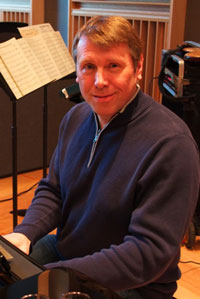
Hiro Honshoku
Thomas Hojnacki
For media inquiries, please contact Media Relations
Thomas Hojnacki has had an unusually varied musical career. As a keyboard player, he has worked with the national touring productions of A Chorus Line, Altar Boyz, and the Big Apple Circus. He has appeared with the Prague Radio Symphony Orchestra, the Claflin Hill Symphony Orchestra, and the New Bedford Symphony Orchestra; and as a chamber musician in performances of the music of Brahms, Schubert, Bartók, Messiaen, and Shostakovich. As a jazz pianist, Hojnacki has appeared with Billy Pierce, Joe Lovano, Jimmy Giuffre, George Garzone, and many others. As a conductor, he has led numerous performances of ballet, opera, musical theater, and symphonic repertoire.
Hojnacki has written more than 50 compositions, including works for musical theater, orchestra, band, chorus, and various chamber ensembles. He has made a number of recordings, most notably "Symphony No. 1" with the Dvorák Symphony Orchestra (Prague) and Julius Williams, conductor. He has taught at Dean College and the New England Conservatory of Music. He is currently the assistant chair of the Harmony Department at Berklee, where he teaches theory, composition, piano, and conducting. Hojnacki is coauthor, with Joe Mulholland, of The Berklee Book of Jazz Harmony.
- Composer, conductor, and pianist
- Performances with Marcus Belgrave, Brass Attack, Amanda Carr, East Side Horns, George Garzone, the New Bedford Symphony Orchestra, the Prague Radio Symphony Orchestra, and many more
- Principal guest conductor of the Claflin Hill Symphony Orchestra
- Recordings include "New Orleans March," MMC New Composers Series, Slovak Radio Symphony Orchestra, Robert Black conductor; "Symphony No. 1," Midnight Tolls, Prague Dvorak Symphony Orchestra, Julius Williams conductor; "Toon, Variations and Fugue," Musique que Faire Plaisir, Berlin Saxophone Quartet
- Compositions include choral music, orchestra, band, and chamber music, including All through the Night: The New Christmas Carol Musical
- Citation for special artistic merit in musical composition from GEMA (a German performing rights organization)
- Musical director, conductor, and keyboardist for more than 50 theater productions, including opera, musical theater, and ballet; productions at the Charles Playhouse, the Stuart Street Playhouse, the Providence Performing Arts Center, Theatre by the Sea, Worcester Foothills Theatre Company, the Cutler Majestic Theatre, the Colonial Theatre, and the North Shore Music Theatre
